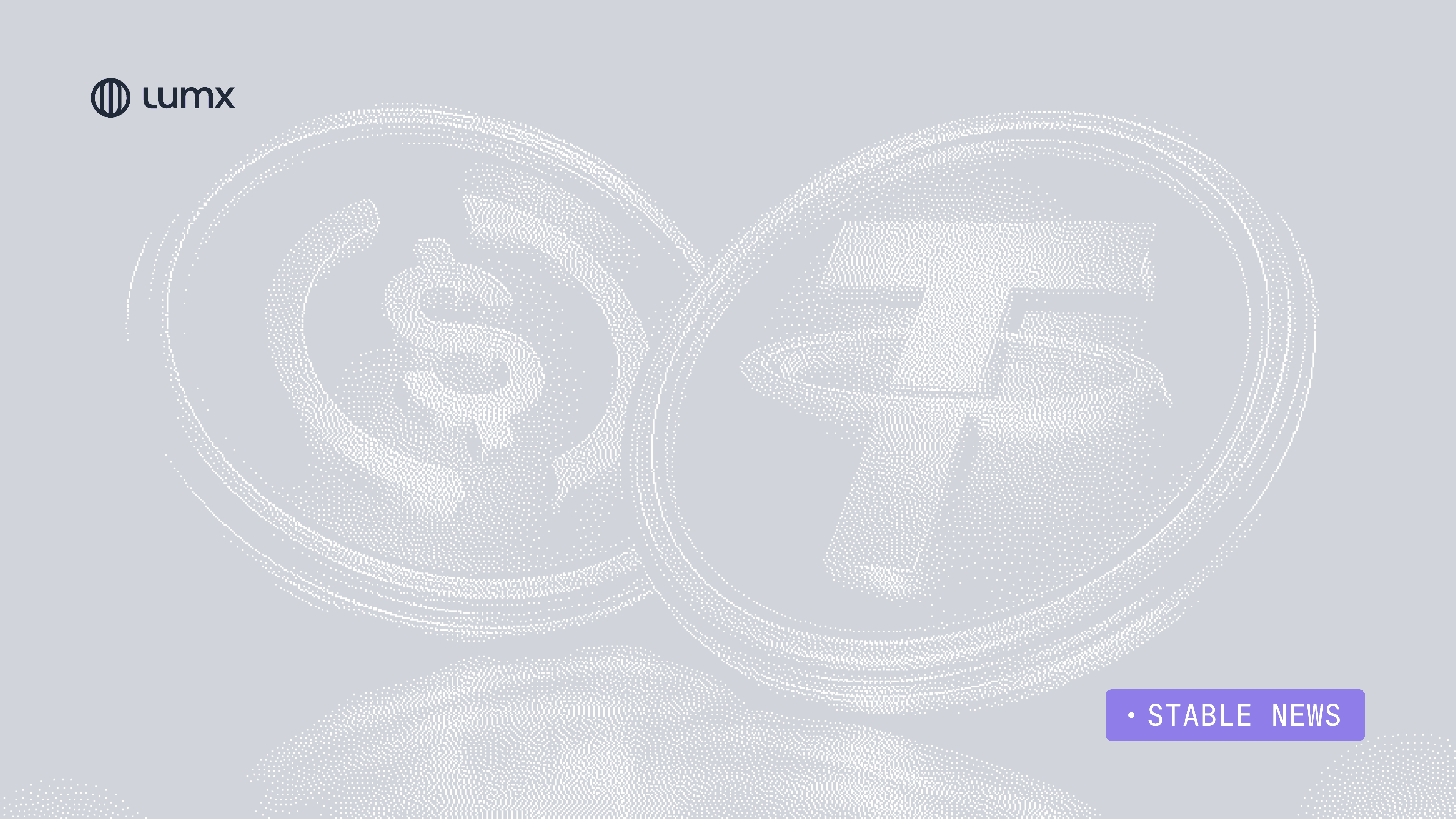Stable News is Lumx’s weekly curation of the key developments in stablecoins, tokenization, and digital payments infrastructure. In this edition: the debut of Stripe’s Tempo blockchain, Goldman Sachs’ report cementing stablecoins in global finance, Ethereum’s dominance in RWAs, Hyperliquid’s battle for its native USDH stablecoin, and mass adoption of stablecoins in Venezuela.
Reading time: 6 minutes
You might also like:
→ What are stablecoins and why they are redefining payments in Latin America
→ From Circle to Hong Kong: the advance of stablecoins in the digital financial system
→ How B2B fintechs are approaching stablecoin payments
Stripe and Paradigm Introduce Tempo, a Blockchain Purpose-Built for Payments
Stripe and Paradigm announced Tempo, an L1 blockchain optimized for payments and stablecoins. The EVM-compatible network promises over 100,000 transactions per second, low fees, and the ability to pay gas in any stablecoin. Design partners include Visa, Shopify, and OpenAI.
The announcement connects back to Stable News #95, where we highlighted the race among major players to build their own blockchains. Stripe’s edge is clear: creating infrastructure designed exclusively for payments, with a focus on liquidity, privacy, and integration with real-world flows like e-commerce, payroll, and remittances.
Why it matters:
✅ Payment-focused blockchains can drastically cut costs compared to traditional card networks.
✅ Controlling the infrastructure gives companies a decisive advantage in the “last mile” between blockchain and the real economy.
✅ The race underscores the paradox: while stablecoins promise decentralization, corporate dominance risks rebuilding silos and concentrating power.
Goldman Sachs: 2025 Is the “Summer of Stablecoins”
Goldman Sachs’ new Top of Mind report calls 2025 the moment of consolidation for stablecoins in global finance. Key highlights include the clarity brought by the GENIUS Act, exploding demand for U.S. dollars abroad, stablecoins’ role in reducing pre-funding in trade, and risks of monetary fragmentation.
The analysis recognizes that while stablecoins won’t immediately replace networks like Visa and Mastercard, they are already part of the system, boosting efficiency and liquidity. And contrary to banks’ alarmist forecasts, Goldman deems a mass deposit flight unlikely, unless stablecoins prove safer and more profitable than banks themselves.
Why it matters:
✅ Recognition from Goldman Sachs legitimizes stablecoins as structural financial assets.
✅ Stablecoins don’t just threaten banks, they reconfigure global liquidity chains.
✅ But the report raises alarms: multiple issuers could fragment “the singularity of money,” heightening systemic risk.
Ethereum Reaches $165B in Stablecoins and Expands Its RWA Dominance
Ethereum saw nearly $5 billion in new stablecoin inflows in just one week, pushing supply to $165 billion, more than double since January 2024 and commanding 57% of global market share. Gold was the fastest-growing tokenized asset on Ethereum, climbing to $2.4 billion.
With over 70% share in tokenized Treasuries and the entry of giants like Fidelity, which launched an on-chain T-Bill fund, Ethereum has solidified itself as the preferred infrastructure for RWAs. This dominance stems from its liquidity, “credible neutrality,” and institutional trust, strengthening ETH as a strategic asset.
Why it matters:
✅ Ethereum confirms its position as the global hub for stablecoins and RWAs, surpassing Tron and Solana.
✅ Growing institutional presence, like Fidelity, legitimizes tokenization in mainstream finance.
✅ ETH’s appreciation shows how institutional adoption and on-chain neutrality can drive native assets higher.
Hyperliquid Challenges Circle With USDH Stablecoin
Hyperliquid, the DEX that holds 70% of the decentralized perpetuals market, launched a process to select the issuer of its native USDH stablecoin. Validators are voting on proposals from Paxos, Sky (formerly Maker), Agora (backed by MoonPay), Native Markets, and potentially even Stripe via Tempo.
USDH’s design foresees sharing nearly all reserve revenue with the ecosystem, validators, insurance funds, and HYPE token buybacks. This model is a direct threat to Circle, since USDC’s revenue from Hyperliquid alone amounts to $200 million annually (almost 10% of Circle’s revenue).
Why it matters:
✅ The USDH battle highlights stablecoins as competitive weapons for both protocols and corporations.
✅ Yield-sharing models challenge the centralized value-capture approach.
✅ Circle, Stripe, and other giants now face native protocols head-on in the fight to control financial rails.
Venezuela: Stablecoins Replace the Bolivar Amid 229% Inflation
With annual inflation at 229%, stablecoins like USDT have become everyday money in Venezuela, popularly called “Binance dollars.” Today, they’re used for salaries, condo fees, and daily purchases, outpacing the bolivar, whose official FX rate is largely ignored in favor of stablecoins’ liquidity and stability.
According to Chainalysis, Venezuela now ranks 9th globally in per-capita crypto adoption, with 47% of transactions under $10,000 happening in stablecoins. This practice has turned stablecoins into an economic equalizer in a context marked by financial exclusion and hyperinflation.
Why it matters:
✅ Stablecoins function as real currency in collapsing economies, replacing systems unable to preserve value.
✅ Venezuela proves stablecoins can be a basic medium of exchange, accessible across social classes.
✅ It suggests global adoption may spread first through crisis economies before reaching major hubs.
Lumx at Stablecoin Conference 2025, Live From Mexico City
Last week, Lumx had a strong presence at the inaugural Stablecoin Conference by Bitso in Mexico City. The company hosted a dedicated booth with product demos, joined the panel “Collaborating for Success: Building a Unified Digital Finance Ecosystem” alongside industry leaders, and also took part in a special episode of the Stableminded podcast, airing soon.
The event reinforced Latin America’s role as a global leader in digital payments, stablecoins, and ecosystem integration. The region continues to attract international players and investors, and hosting a full conference dedicated to stablecoins only cements this status.
It was also announced that Bitso Business will partner with Lumx for the second season of Stable Talks, updates coming soon.
This edition reflects a turning point for stablecoins: global corporations building their own blockchains, traditional financial institutions recognizing their legitimacy, public blockchains consolidating dominance in RWAs, and extreme cases like Venezuela showcasing their role as everyday currency.
The future of digital payments is being contested now, by tech companies, financial institutions, and decentralized protocols. For Latin America, it’s a strategic opportunity: to adopt, shape, and lead this new chapter in the digital economy.
See you in the next edition.








